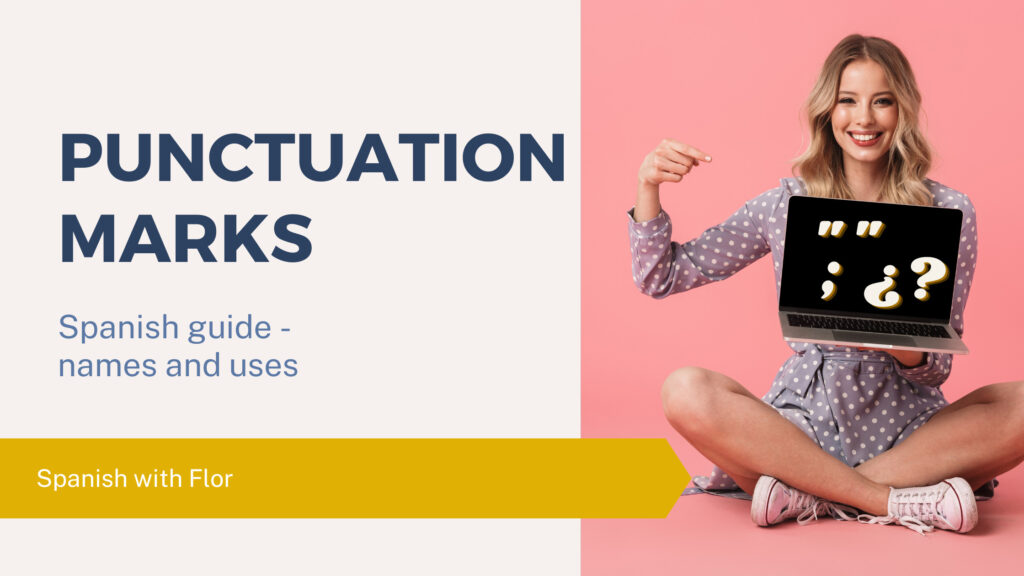Punctuation marks are used to mark the pauses and intonation with which statements should be read, to organize the discourse and its different elements to facilitate understanding, to avoid possible ambiguities in texts which, without their use, could have different interpretations, and to indicate the special character of certain text fragments – quotes, incises, interventions of different speakers in a dialogue, etc.
List of basic punctuation marks in Spanish
coma , (comma)
It is used to mark the existence of a brief pause within an utterance and is always written followed by the previous word or sign and separated by a space from the word or sign that follows it.
comillas “” (quotation marks)
There are three types of quotation marks: angled quotation marks, also called Latin or Spanish («»), English (” “) and single quotation marks (‘ ‘).
The English and single quotation marks are written at the top of the line, while the angled quotation marks are written centered.
They are used to reproduce textual quotations or textual words in an indirect sentence.
corchetes [ ] (square brackets)
Square brackets are used to add complementary or clarifying information. They are also used when it is necessary to introduce a clarification or clarifying note that is in parentheses.
dos puntos : (colon)
They are used to mark a pause longer than a comma and shorter than a period. As linguistic uses, the most common are: to announce an explanatory enumeration, or the reproduction of quotations or textual words and for the salutation in the heading of letters and documents.
signos de interrogación ¿? (question marks)
They are used to mark the interrogative intonation of a sentence or statement.
signos de exclamación ¡! (exclamation marks)
Exclamation marks are used to mark the interrogative or exclamatory intonation of a statement.
How are question marks and exclamation marks written in Spanish?
The opening signs (¿¡) are characteristic of Spanish and should not be omitted.
The closing signs (?!) can be followed by any punctuation mark, except for the period or full stop. This is because the closing signs are equivalent to a full stop, so the following sentence must begin with a capital letter.
The opening signs (¿ ¡) are written just where the question or exclamation begins, if they follow a comma, for example, the question or exclamation begins with a lowercase letter.
When several short questions or exclamations are written in a row, they are considered as independent sentences. Therefore, each question or exclamation will begin with a capital letter.
Closing question marks written between parentheses (?) are used to express doubt or surprise, exclamation marks (!), in most cases, irony.
paréntesis ( ) (parentheses)
They are used to insert complementary or clarifying information such as: dates, places, the development of an acronym, the name of an author or a work cited, etc.
They are also used to introduce options in a text by enclosing these options in parentheses, either a complete word or one of its segments.
Examples:
Se busca chico(a) para repartos. – Wanted boy/girl for deliveries.
Se convoca una asamblea comunitaria el (los) día(s) a definir por la administración. –
A community assembly is called for the day(s) to be defined by the administration.
punto . (stop/ period)
It is used to mark the end of a statement, whether it is a paragraph or text.
The full stop or period is written at the end of a statement and then, on the same line, another one begins. The semicolon is the sign that separates the statements that make up a paragraph.
The full stop or “ punto y aparte o punto aparte” is the sign that is written at the end of a paragraph and the following statement starts a new paragraph.
puntos suspensivos … (ellipsis)
They are composed of three dots and are used to mark suspense in speech. It is also commonly used to insinuate expressions or inappropriate words or expressions. It is also used at the end of open or incomplete enumerations, with the same value as the word etcetera or its abbreviation.
punto y coma ; (semicolon)
Among the uses of the semicolon, it is used to indicate a pause longer than the one marked by the comma and shorter than the one marked by the period. It is also used to separate the elements of an enumeration in complex expressions that include commas.
In longer sentences, it is written before connectors of an adversative, concessive or consecutive sense, such as but, more, although, however, therefore, consequently, etc.
raya — (dash)
It is used to enclose clarifications or incises, to introduce a new clarification in a text already enclosed in parentheses and it is also used in the written reproduction of a dialogue. In this case, the dash precedes the intervention of each of the speakers, without mentioning their names.
Two dashes (one opening and one closing) can also be used to introduce a clause within a longer period.
How to type punctuation marks in Spanish
| ¿ (inverted question mark) | Press Alt + Ctrl + Shift + ? (question mark) |
| ¡ (inverted exclamation mark) | Press Alt + Ctrl + Shift + ! (exclamation mark) |
| « (opening angle quotation mark) | Press Ctrl + ` (grave accent), then Shift + < (less than symbol) |
| » (closing angle quotation mark) | Press Ctrl + ` (grave accent), then Shift + > (greater than symbol) |

